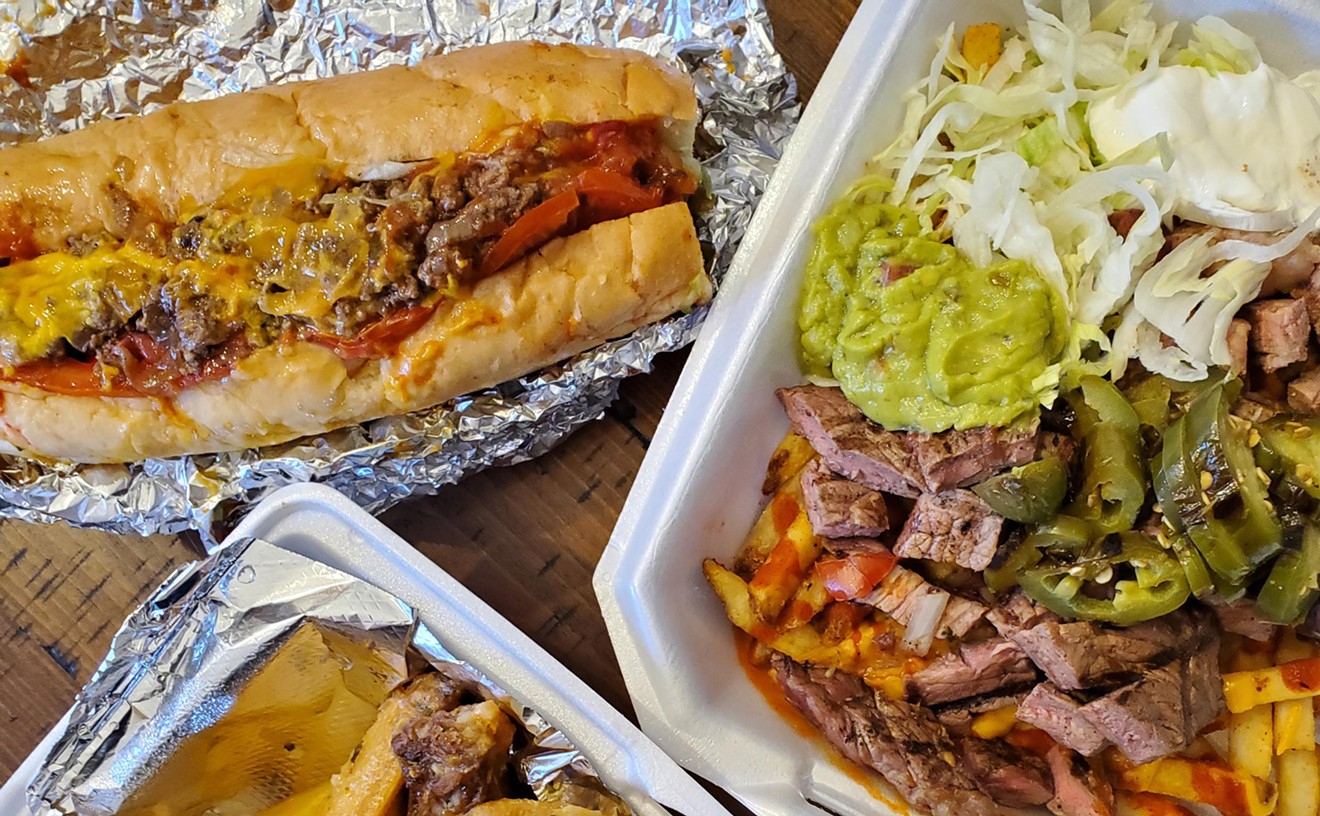There are some foods that become sacred through nothing more than fierce love and attachment. Your mother's meatloaf, Sunday-morning pancake breakfasts, the roasted chicken your wife made the first time she cooked for you, pressed with the indents of her thumbs and speckled with fresh thyme. And there are entire cuisines that, through commitment and bitter history, take on a kind of internal holiness — a private potency that can imbue a canon with incredible power and weight.
I have that relationship with French food, with pure (or anyway, purely American) Edo-mai sushi, with Vietnamese, to a certain extent. Sushi I came to slowly, haltingly — a penitent trying to make amends for my Rust Belt upbringing and the fact that the first sushi I knew and loved came from a grocery store, packed (along with a shred of fake grass and a pasty blob of green horseradish) in a plastic clamshell to-go and eaten in secret, on afternoons when I'd skip out of my high-school study hall to smoke cigarettes and eat tekka maki. Vietnamese food I fell for while a line cook, eating out the back door of a couple of Vietnamese restaurants with my crews — rolling up like beggars after we'd shut down our own kitchen and stepping into the warm, wet heat of another to eat fried softshell crabs and noodles with the staff, cooked by first-generation immigrants — guys who cared nothing for stars or Le Methode or one-upping the crew across the street, but were only concerned with getting back to Saigon or Hue, going home one bite at a time.
I was so moved by this (and by the strange intersections of Vietnamese and French cuisine in the boudin noir steeping on the steam table, and the way the cooks would spatchcock their chickens in preparation for roasting them) that when I found myself, some years later, in a kitchen that claimed a colonial French inspiration, I threw myself wholeheartedly into the construction of three pho broths for the menu, the acquisition of star anise and lemongrass, perfect vermicelli noodles and raw stock bones. This, while at the same time perfecting my own bâtonnet cut and julienne (because I was, and remain, terrified of the mandoline), babysitting mother sauces straight out of Larousse and gritting my teeth over the anachronistic inclusions of black-olive tapenade and skordalia and Italian arrabbiata sauce on my prep list. For me (or at least for the me that remembers the high joys and discontents of being a station chef), La Cuisine has always been like a religion: something to which you dedicate your life and commit every labor, complete with its own hierarchy of saints and demons, more satisfying and far less forgiving than anything the pope ever knew.
And yet my personal commitment to the Froggish arts is nothing when compared to the two-line backstory of Uttam Lama, chef at the five-month-old Tibet's Restaurant in Louisville.
Uttam spent fourteen years as the chef at a Tibetan monastery.
While there, he cooked for the Dalai Lama.
For culinary street cred, Uttam has it over just about anyone working today. Not only does he have the whole "I spent fourteen years at a Tibetan monastery" thing (an admission generally followed in American culture by something like "...and now have returned to kick your ass with my Leaping Buddha kung fu!" or "...just like Bill Murray in that movie The Razor's Edge"), but cooking for His Holiness the fourteenth Dalai Lama? To quote another Bill Murray character, groundskeeper Carl Spackler in Caddyshack, who once caddied for the twelfth Dalai Lama in Tibet: "So we finish the eighteenth and he's gonna stiff me. And I say, 'Hey, Lama, hey, how about a little something, you know, for the effort, you know?' And he says, 'Oh, uh, there won't be any money, but when you die, on your deathbed, you will receive total consciousness.' So I got that goin' for me, which is nice."
But total consciousness on your deathbed does not necessarily translate to cooking skills while alive. I imagined it could be rough finding experienced, talented chefs to run kitchens in Tibet, so there was always the possibility that this Uttam character was simply the only guy the monks could get — a local boy, familiar with the cuisine, comfortable with working thousands of feet above sea level. And in Tibet, the monasteries could be like B&Bs in New England, always boasting of their relationship with George Washington, with every damn one of them sporting a plaque or a scroll or something: The Dalai Lama Ate Here...
There was only one way to find out: I had to make the trek to Louisville.
Tibet's is owned by Kami Sherpa and Pasang Sherpa, and related through blood (though not money) to another great Tibetan restaurant: Sherpa's Adventurers Restaurant in Boulder. It's staffed by some of Sherpa's former waiters, and Pasang himself works the floor while Uttam cooks. But while the board might look similar to that of Sherpa's (Tibetan and Indian cuisine, mixed), it's only in the way that one Mexican restaurant might be called similar to another just because both serve tacos. Walking in the door of Tibet's, I was immediately struck by more differences than similarities.
Where Sherpa's takes the very cool notion of being an adventurer's rest and runs with it, decorating the walls with ice axes and pictures of past mountain-climbing expeditions, Tibet's goes in another direction — using both the space and the menu to glorify, to share, to remember Tibet. There are prayer wheels by the door and Karmapa dream flags hung from the ceiling. Beside the short bar, a stone fountain flows beneath a garlanded picture of the current Dalai Lama and a gold Buddha sits, wreathed in incense, holding dollar bills. Buddha's eyes are everywhere — on banners, in the restaurant's logo — as are photographs of soaring mountains, endless stony plains and smiling, shaven-headed boys in purple monk's robes. It is a lovely, spacious and glowing room, peaceful and comforting, with a fire in the grate, full of the sounds of Tibetan music and the smells of Tibetan food.
On my first time through, I felt somewhat overwhelmed, somewhat lost in the wash of someone else's fond memories of a place I'd never been. But that happens to me a lot, and the trick is to just roll with it — to throw yourself fully into whoever's dream you've stumbled into — and so I drank cold mango lassi, broke pieces off the crisp papadum laid in the basket on the table and dipped them in cool yogurt, in tamarind chutney, in a kind of Himalayan salsa of chile and cumin and tomato, and waited for my order of momo to arrive. Momo are Tibet's version of dumplings, and dumplings are common to just about every cuisine on earth — eaten from Indianapolis to Paris to Lhasa and back again. And these momo were delicious: thick-skinned and chewy, the doughy skins wrapped around a core of spiced ground beef and filled with ghee (clarified butter, central to almost all Eastern cuisines from Africa, through India and north to Nepal). Bread is another common comfort of the topologically displaced, and while I have heard many expatriate New Yorkers and more than a few French immigrants complain about the impossible suckiness of bread made at Colorado's altitude, I have never heard a Tibetan bitch — because high-altitude bread is what a Sherpa will want, will crave: naan puffed and charred against the wall of a tandoor oven, flat paratha stuffed with potatoes, and Tibetan wheat bread, lightly fried, almost like a heavy American Indian fry bread.
By the time my saag arrived, I was already full, subsumed into the sounds, the smells, the flavors of another place that bears many similarities to Colorado's Rockies but is also completely alien, completely other. And with each bite of the saag, I was drawn farther away from this Louisville strip mall with its Dairy Queen and Chipotle franchises, laddering down an architecture of spice into a food culture defined and separated from Indian, from Mongolian and Chinese, by its austerity, by what isn't there as much as by what is. Tibetan saag is to Indian saag as a cup of water is to the sea. Both are water, one is simply more. Indian saag is a chorus of balanced spices singing across a solid baseline of creamed spinach. Tibetan saag — Uttam's saag — is garlic, ginger and cumin, spinach, onions and cream. And that's all. It is saag simplified, stripped down to absolutes and served rough-edged and full of bursting flavors. There is no subtlety, but neither is there anything hidden.
From the deliciously straightforward and pale-orange lamb tikka masala (made with tandoori lamb in a sauce of tomatoes, cream and onions) to the Himalayan curry (in a sauce of tomato, garlic, ginger and onion) and the chana masala (chickpeas with ginger and garlic in a tomato/onion/cream sauce), everything I ate at Tibet's was delicious, stripped bare of pretense or artifice, nearly ascetic in its presentation of flavors: This is lamb, this is paneer, this is a touch of cumin, a spark of garlic, a taste of caraway. The Tibetan comfort foods (the thukpa with homemade noodles that I swear must've once been the historical predecessor to the wheat-flour noodles of China, and thenthuk stew of lamb and potatoes, carrots, cauliflower and wheat-dough dumplings) were the same, only marked with the added sense of historical, generational solace that someone else might feel for a traditional cod chowder, a bowl of champ, a ball of sweet rice.
Like those Vietnamese cooks who used their woks and knives to recall the comforts and flavors of their distant homes, so, too, does Tibet's serve as a touchstone for a staff making its way in a new world and remembering with every breath, every movement, the one they've left behind. The flavors are powerful, the sense of longing a sweet undertone, the happiness of the cooks in the kitchen and the servers on the floor palpable as they offer these tastes to dummies like me who, with my different obsessions, might never be able to understand the intrinsic reverence of the cuisine for hearth and height and home.
But the wonder is, I don't have to. At Tibet's, all I have to do is eat.










